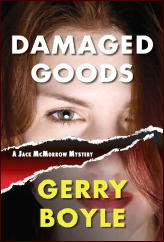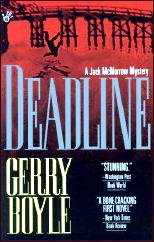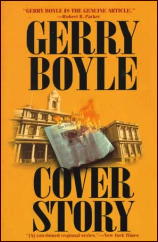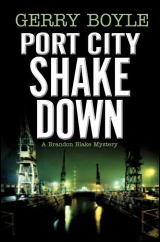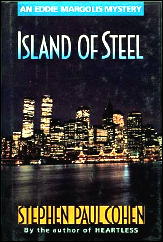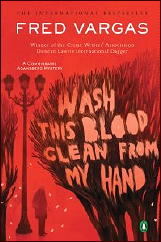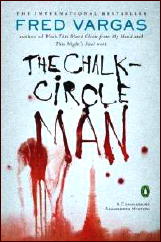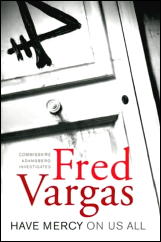FIFTY FUNNY FELONIES (+ FIFTY MORE)
A List by David L. Vineyard.
“Dying is easy, comedy is hard.”
— attributed to great actor David Garrick on his deathbed and since then to at least a dozen others including Edmund Gwenn.
Steve suggested the title of this one and the theme, so praise — and/or blame — should go to him.
The chief rule for this is the book in question had to make me laugh: a hearty guffaw, a dry chuckle, a knowing smile — that and that indefinable thing called charm are the chief attributes of the books on this list; and of them, charm is the one that weighed the heaviest.
Of course being funny is serious business as any comic will tell you, and nothing is harder than being consistently funny at novel length while still producing a discernible plot, actual characters, and a genuine mystery and suspense. All these succeed on that level — or they did for me.
Taste is always subjective and humor the most subjective of all. For that reason I expect this to promote some argument. That said, some short story and novella collections made the list, and in a few places more than one book by some writers.
You’ll find some of the usual suspects here, but where I could I went for a less well known title by a less well known writer if it was one I particularly liked. These are favorites and not bests, and I’ve tried for a variety.
If I have overused the words ‘droll’ and ‘wit’ it is because for me those are far more common qualities in the comic mystery or thriller than belly laughs.
As always, just because a book is not on the list doesn’t mean I didn’t find it funny or deserving. I’ve avoided books like The Smiling Corpse or The John Riddell Murder Case because they were chiefly satires before they were mysteries.
Also not on the list many of the soft core series and books like Ted Marks’ “Man From Orgy” or Clyde Allison’s “0008” novels — although many of them were very funny.
Film novelizations were left off too, though some, like the ones for Gambit, How To Steal a Million, The Notorious Landlady, and On the Double were very well done and funny in their own right. The same for TV-tie-ins. I realize that is arbitrary, but without some arbitrary rules these lists would be so all inclusive as to be meaningless.
I ended up without a Donald Lam mystery by A. A. Fair, but let it be said the entire series is bright and sprightly, and for my money’s Gardner’s best. Somehow Cleve Adams, Robert Leslie Bellem, Robert Reeves, Kurt Steel, Kelly Roos, Jimmy Starr, Martin Wodehouse, Alice Tilton (though she made it as Phoebe Atwood Taylor), and some other obvious choices didn’t make the list, but that doesn’t mean they did not deserve to. On a different day in a different mood some choices would be different.
In a few cases time has passed a book by, and what was very funny then is at best mildly humorous now. This included books like The Disentanglers by Andrew Lang.
Mostly I limited myself to one book by author, but in the case of Stuart Palmer and Craig Rice allowed for a collaborative effort to stand on its own. Many writers such as Palmer, Rice, Fish, Block, and Westlake could easily make up a list of their own.
I did not forget Thorne Smith’s Did She Fall? I just thought it was poor Smith and a mediocre mystery.
At the end I have added fifty more without comment.
As usual an * indicates a film or television adaptation.
The Light of Day (aka Topkapi) * by Eric Ambler — Any one who knew Ambler’s screen work should have known he had a dry wit, but this took everyone by surprise, although Arthur Abdel Simpson, Ambler’s illegitimate stateless half British half Egyptian pimp and pornographer ‘hero,’ is well within the Ambler tradition. Not as playful as the Jules Dassin film, but in many ways funnier and more suspenseful. Other Ambler’s in a playful mode; Send No More Roses, Dirty Story, A Kind of Anger, and Dr. Frigo. Peter Ustinov, Melina Mercouri (Mrs. Dassin), Maximilian Schell, Robert Morley, and Akim Tamiroff starred.
Chip Harrison and the Topless Tulip Caper by Lawrence Block — There are too many to choose from by Block, from the exploits of burglar/bookseller Bernie Rhodenbarr to sleepless Evan Tanner, to hit man Keller, but I choose this paperback original because it is as good a portrait of an adolescent in the throws of sexual awakening as anything by Roth or Salinger, and because it is a dead on satire/tribute to Rex Stout and Nero Wolfe and Archie Goodwin. It is also cheerfully dirty minded without a smirk or a snicker — a rarity in any American fiction.
Rocket to the Morgue by Anthony Boucher — A nun, Sister Ursula, and a harried cop, Terry Marshall, must team up to solve a murder at a convention of science fiction writers. As if that wasn’t enough, the book features savage but affectionate portraits of some of the titans of the science fiction field and a barbed look at early fandom as well as a satisfying mystery plot. Boucher’s Fergus O’Breen mysteries are similar blends of laughs and detection, by a man whose bona fides in the mystery and science fiction field are unquestionable.
A Case for Three Detectives by Leo Bruce — Discussed here recently. Sgt. Beef, a solid and seemingly plodding policeman shows up three spoofs of famous Golden Age sleuths (Lord Peter, Poirot, and Father Brown) and solves a fine fair play murder along the way by an under acknowledged master of the form. A surprisingly fresh read.
Huntingtower * by John Buchan — Dickson McCunn is a canny Glasgow grocer who has just retired and wants a little adventure, so he sets out on a walking holiday in Scotland and gets a bit more than he bargained for including a Bolshie poet, a Russian princess, royal jewels, dastardly villains, and a ragtag Boy Scout troop known as the Gorbals Diehards who could give the Dead End Kids and Bowery Boys a run for their money. First of three delightful books about McCunn and the Diehards, If possible catch the BBC radio adaptation (it was also a silent film and adapted at least twice for television). It may remind you a bit of the great Brit comedy Hue and Cry.
Surprise Package * by Art Buchwald — A less than honest Union Boss gets deported to the tiny island where he was born, and along with his ‘moll’, who proves to be more than he — or anyone — can handle, finds himself scheming to get home, steal the crown from an exiled playboy king, and outwit corrupt police and ruthless thugs trying to take the crown back to his highness now Communist homeland. There’s also a band of patriotic monks in the mix who want the crown for religious reasons. Broad satire, but very funny, and I admit I liked the film much more than most do. Yul Brynner, Mitzi Gaynor, and Noel Coward starred with a script by Harry (Marco Page) Kurnitz.
The Great Affair by Victor Canning — The title is from a quote by Robert Louis Stevenson ( “The great affair is to travel.”) and Canning, in a rare funny mood, provides an entertaining romp for a somewhat straight laced missionary in Africa who discovers his real talent lies in decidedly less legal and moral pursuits.
The Arabian Nights Murder by John Dickson Carr — Dr. Fell takes on a case that owes as much to the Marx Brothers as Edgar Allan Poe, and Carr proceeds on a romp of epic proportions that is both very funny and still a fine example of the form. Carr indulges his penchant for the bizarre, the gargantuan Fell’s eccentricities, and Eighteenth Century drolleries, wit, and rambunctiousness so effortlessly you likely won’t care how contrived and unreal it all is. In fact, that is half the fun. We even get Carr’s idea of a sexpot.
The Man Who Was Thursday by G. K. Chesterton — Nothing dates faster than yesterday’s whimsey, but this bright and allegorical phantasmagorical tale still shines. Poet Gabriel Syme (The Poet and the Lunatics) stumbles on a secret society of anarchists, is recruited by Scotland Yard to infiltrate them, and moves up the organizations ladder through members named for the days of the week until he encounters the leader of the group — Sunday. Just read it, no explanation or description could do it justice. The reading of this on BBC 7 by Geoffrey Palmer (As Time Goes By) was particularly good.
Arigato by Richard Condon — Captain Huntington is a former RAF hero married to a beautiful American heiress. He also has a few gambling debts his wife is refusing to pay for, so Captain Huntington needs to raise a little money — quick — and has few scruples about doing it. Condon was one of the masters of the sharp observation and the pen as scalpel, and this little book and its companion simply ooze charm and invention. If your prefer him a bit more savage try Whisper of the Axe or closer to home, Prizzi’s Honor — or any of the Prizzi books. Also check out his caper novel The Oldest Confession and his savage Hollywood satire, The Ecstasy Business, about a madman trying to kill a Liz Taylor/Richard Burton pair of movie idols. If you only know him from The Manchurian Candidate, Prizzi’s Honor, or Winter Kills, you have some wonderful reading ahead of you.
Love Lies Bleeding by Edmund Crispin — Oxford don Gervase Fen gets involved with a missing Shakespearian play, murder, the kidnapping of a little girl, an aged an demented bloodhound, and the usual patented Crispin chasing around in a fine example of what Crispin did best. Crispin, who was composer Robert Bruce Montgomery, wrote the scores for the “Carry On” films among others, and knew his way around comedy and the detective novel. This one wins out over the others for me only for that magnificent senile bloodhound. Almost any of the Crispin books would have made a perfect Ealing comedy.
Sally in the Alley by Norbert Davis — Carstairs and Doan are a mismatched team of private eyes. Carstairs is a highly bred aristocrat and Doan is a bit of a mutt. Carstairs is also a prize winning Great Dane, who thinks his private eye owner Doan is a bit beneath him. Together they featured in three books and a long short story that show Davis skills at plotting, orchestrating, and amusing. It I choose this one over the others it is mostly because I was married to a Sally.
The Incredible Schlock Homes by Robert L. Fish — Finding a new Schlock Homes story in Ellery Queen’s Mystery Magazine was always a delight. Overrun with puns, absurdity, and sheer manic energy they are to Holmesian satire what the original was to detective stories. Read them and weep with laughter.
The Liquidator * by John Gardner — Boysie Oakes is a genial but attractive idiot recruited as chief executioner for the British Secret Service by the loathsome Colonel Mostyn, and forced to hire a Cockney hit man, Charlie Griffin to do his job for him. Boysie’s adventures manage to both thrill, amuse, and postillion the whole James Bond thing — ironic when you recall Gardner ended up replacing Ian Fleming writing the Bond saga. The film starred Rod Taylor, Jill St. John, and Trevor Howard as Mostyn, with Eric Sykes as Griffin.
The Megstone Plot * by Andrew Garve — A decorated submariner stuck in a desk job at the Admiralty would like to marry a beautiful but mercenary lady, but lacks the money so he sets out to frame himself for treason and then collect big by suing the tabloid press for libel when he is cleared. What could possibly go wrong … A droll book that was an even droller film with James Mason, Vera Miles, and George Sanders as A Touch of Larceny.
The Devil in Amber by Mark Gatiss — The second outing for bisexual Edwardian artist and spy Lucifer Box, who works for the real British Secret Service, the Royal Academy. Here he is sent to America in the twenties to look into a proto-Fascist group known as the Amber Shirts founded by one Olympus Mons, runs into his hated sister, Pandora, is framed for a shocking murder, and must save a young woman (Agnes Daye) and the world from a plot to literally raise the devil. Gattis is an actor (the BBC sitcom The League of Gentleman) and writer (Doctor Who) who can keep the pages turning and you chuckling, with the most likeable scoundrel since Harry Flashman. Gattiss own five part reading and adaptation of this was recently featured on BBC7.
The Unexpected Mrs. Pollifax * by Dorothy Gilman — Mrs. Pollifax is a well to do widow with grown children who just wants to serve her country — so she volunteers for the CIA. Of course the CIA isn’t interested, but then they have this little problem in Yugoslavia, and Mrs. P. might just prove useful — nothing too dangerous of course — like breaking out of a Yugoslav prison with a wounded American spy and being pursued by the entire army and secret police … First of a long and delightful series of well plotted and ably told adventures all preceding from the simple premise of the entire world underestimating Emily Pollifax. You shouldn’t. Rosalind Russell and Angela Lansbury both essayed the role of Mrs. Pollifax in the film and television versions of this.
A Thrill A Minute With Jack Albany * by John Godey — Jack Albany is a character actor with the kind of face that keeps him on screen — as a long procession of cheap hoods, tough gangsters, and assorted thugs. So when a criminal mastermind mistakes him for a deadly hitman… Entertaining tale from a writer better known for the suspense novel The Taking of Pelham, One Two Three. This was a Disney film, Never a Dull Moment, with Dick Van Dyke, Dorothy Provine, Edward G. Robinson, Henry Silva, and Joanna Moore.
No Way to Treat A Lady * by William Goldman — A charming New York homicide cop with a Jewish mother and a shiksa girlfriend, a serial killer with mother issues and a penchant for theatrical disguises — these are the elements of a fine mix of laughs and thrills that was also a memorable film with George Segal, Lee Remick, and Rod Steiger.
Our Man in Havana * by Graham Greene — Mr. Wormwold is a widower with a teenage daughter, and sells vacuum cleaners in Havana on the eve of the Castro Revolution. What he mostly wants is to make a little money and go home because his teen daughter is a ripe young thing and in Havana her age is even less protection than in the rest of the world, so when a persistent British spy recruits him Mr. Wormwold doesn’t see what harm it could do to have a little extra income — and he doesn’t have to actually spy on anyone — he can just make if all up while padding his expenses. Which is how he becomes the most important agent in the western hemisphere and up to his neck in spies, killers, secret police, and betrayal. Also a notable Carol Reed film with Alec Guiness, Ernie Kovacs, Maureen O’Hara, Noel Coward, and Burl Ives. Sharp satire on politics, spies, sex, and life in general by one of the masters of the form, and you will never look a vacuum cleaner or play chess quite the same again.. For Greene in a humorous vein also try Travels With My Aunt, Lovers Take All, Monsignor Quixote, and Dr Fischer of Geneva or The Bomb Party.
It Happened In Boston by Russell Greenhan — For more detail see my review. A forger who complains because the old masters keep copying his work gets involved in a deadly plot and goes happily off the cliff taking us with him. To say the least, this book is unique.
The Thin Man * by Dashiell Hammett — Nick and Nora Charles are the templates for all the bright brittle husband and wife sleuths to come, bantering, detecting, and destroying their livers, all with equal glee. Hammett succeeded at making marriage sexy, and then William Powell and Myrna Loy succeeded at making it effortless. While it is the least of Hammett’s novels it is still a damn good detective story and a refreshingly good read today with the sharp dialogue and Nick’s dry wit both intact. Though in all fairness Hammett himself hit on one of the minor problems when he lamented no one ever invented a more smug pair.
Just Desserts by Tim Heald — Simon Bognor, that overweight and less than brilliant agent of the Inland Revenue, customs and taxes, has a love of good food, so he doesn’t mind too much when he is asked to look into the murder of a famous chef he knew, even if he is still not sure how he ended up working for the Inland Revenue in the first place. Pretty soon he is overseas on the expense account, attracted to a young lady his fiancee would not approve of, and up to his neck in murder and fraudulent champagne. Yet another fast moving, clever, and funny entry in the entertaining series which began back in Unbecoming Habits with Simon looking into a little truth in labeling problem involving a mysterious group of monks. If you don’t know these discover them.
Why Shoot a Butler? by Georgette Heyer — A bit of entertaining froth from the mistress of the Regency romance and the creator of sleuths Hannayside and Hemingway, this sprightly comedy mystery reads the way a good British comedy mystery of the era plays on screen. There is a handsome likable hero, an attractive heroine in trouble, a mystery to be solved, a satisfying amount of shooting around in the dark on narrow foggy country roads in low slung roadsters, and a better crime, plot, and solution than is really needed to make it fun. Why shoot a butler? Why not, if the result is this much fun?
A Fairly Dangerous Thing by Reginald Hill —Joe Askern, who teaches English in a small English village, has a passion for the local stately hall, Averingrett, and comely ladies with well developed bosoms. When he is recruited by a ring of professional thieves, who plan to systematically loot the stately hall, thanks to a call girl named Cynthia who is more than amply endowed in his other area of interest there are bound to be complications. Just how it all ends for the best is a delightful trip that reads like a slightly risque Ealing comedy.
Fellow Passenger by Geoffrey Household — Household indulges both his skill at chase and pursuit and his penchant for the picaresque in this tale narrated from the Tower of London, by one Claudio Howard-Wolverston, who finds himself trying to extricate himself from a series of increasingly dangerous coincidences that leave him at sea in a dangerous storm and working as an elephant trainer in a circus while trying to maintain his freedom and clear his name. Household’s best mix of the classic elements of his Rogue Male type novel in a lighter vein. Also check out Olura and The Life and Times of Bernardo Brown for more in this mood.
One Man Show by Michael Innes — Sir John Appleby takes on art crime in this high handed caper that proceeds like The Lavender Hill Mob or The Ladykillers with chuckles, smiles of recognition, and some expertly orchestrated belly laughs. For my money, this may well be Innes’s masterpiece in terms of all the elements of mystery, movement, and humor. The heist and chase is beautifully choreographed. Almost all the Innes novels are droll; try also his non-series novel Candleshoe.
Lady in the Morgue * by Jonathan Latimer — Bill Crane takes a nap in the morgue (and if you drank like he did you could sleep anywhere too) and wakes up to murder. Meanwhile he’s hunting a missing heiress and two gangsters are fighting over one’s missing wife. Crane, who is the top detective for Colonel Black’s agency teams with his pal Doc Williams and manages to stay one step ahead of the cops while drinking like a fish and indulging in some still fairly racy patter and situations. On top of all the other virtues of this unvirtuous book it is wonderfully written and a damn good detective story with actual clues and deductions. Preston Foster was good as Crane in three cheap but effective Crime Club films with Frank Jenks as Doc. Latimer was likely the raciest writer of the screwball school, with Crane having a penchant for naked ladies unsurpassed until Mike Hammer. If anything The Dead Don’t Care and Red Gardenias are even more screwball and racier, as is his ultra-tough Solomon’s Vineyard.
The Gun Seller by Hugh Laurie — Television’s House, and Bertie Wooster, not to mention Blackadder’s benighted buddy, penned this top notch and laugh out loud funny thriller, about an ex-Special Forces type who tries to do a good turn and ends up battling terrorists and a plot to sell tactical missiles by staging a terrorist atrocity. If that doesn’t sound funny, imagine it narrated in Laurie’s dry acerbic style with just enough sense of the ridiculous to leaven the very real suspense and violent action. I have seldom been as thrilled by a book I laughed out loud out at.
Out of Sight * by Elmore Leonard — He’s a charming crook escaped from prison and she’s a U.S. Marshall assigned to catch him, of course falling for each other while he tries to elude capture and she tries to bring him in is out of the question. Made into an entertaining film with George Clooney and Jennifer Lopez by Stephen Soderbergh. And yes, I Iike this much better than Get Shorty or Maximum Bob, but both are also very funny.
The Norths Meet Murder * by Richard and Frances Lockridge — After Nick and Nora Charles Jerry and Pam North are the epitome of the married with murder set. Originating in a series of sketches in The New Yorker, Lockridge combined the Norths with murder and his career was set (by all accounts Frances only contributed her name and Pam’s character). This first one is as good a place as any to dip in. Despite being played by Gracie Allen in their only film, Pam, in the Nora Charles tradition, is one of the sexiest wives in fiction. The cats never bothered me, but you may not be so tolerant. This one as recently commented is also a fine snapshot of the period it was written in. Barbara Britton, from the television series with Richard Denning, was much closer to my idea of Pam North.
Venus With Pistol by Gavin Lyall — Humor isn’t the first thing you think of in relation to Lyall’s brilliant thrillers, but this one about a dealer in rare and sometimes spurious antique guns who finds himself drawn into a scam of international proportions with a mercenary and amorous princess and some very bad men is both very funny and very exciting. The book was delayed for several months while Lyall experimented to see the trick with the antique gun could actually work.
Who Is Killing the Great Chef’s of Europe? * by Nan and Ivan Lyons — a beautiful chef and her ex-husband, a gauche American fast food entrepreneur, find themselves as suspects, targets, and sleuths in this sophisticated romp through the best kitchens in Europe as someone is targeting and murdering Europe’s finest chef’s with their own specialties. Could it be the food critic and gourmand who is dying because of all their rich foods he can’t resist? This was made into a charming film with Jacqueline Bissett, George Segal, Robert Morley as the food critic, and various guest stars as the chef’s and a script by Peter Stone (1776, Charade). Re-read and re-viewed recently both are as good as remembered.
Please Write For Details by John D. MacDonald — Yes, I know most of you would have chosen The Girl, the Gold Watch, and Everything, but this clever con artist scheme has always seemed to me under appreciated as an art colony fraud involves the usual collection of MacDonald characters and who is double crossing whom gets lost in the complications.
Whiskey Galore * by Compton Mackenzie — A crisis strikes a small Scottish island when the war interferes with their ration of whiskey. Things are getting pretty desperate until a ship laden with the precious stuff is run aground on the nearby rocks. A desperate plan is then unfolded to salvage the cargo, but that is only the start of their problems as the Royal Navy and the excise man both want to know where the whiskey went precipitating a heroic effort by the entire island population to hide the precious cargo. Charming comic novel by a leading literary light who dabbled in spy novels too. Made into one of the funniest British films ever as Whiskey Galore, aka Tight Little Island by the legendary Ealing Studios. No, it isn’t in Hubin, but technically I consider smuggling and evading the police at the least a crime novel. Mackenzie himself has a small role in the film.
Let’s Kill Uncle * by Rohan O’Grady — a pair of orphans stand to inherit their parents fortune, if they can survive being sent to live with their ex commando uncle in Canada, who in turn stands to inherit if something should happen to them. What are the poor dears to do? Murder comes to mind — more-or-less in self defense. Black comedy made into a decent William Castle film with Nigel Green the homicidal uncle.
The Penguin Pool Murders * by Stuart Palmer — Spinster schoolteacher Hildegarde Withers is one of the great contributions from the American school of the detective novel, a woman with steel in her backbone as well as her whalebone in her stays, and a fine appreciation for spotting skullduggery after years of teaching children. That her foil Oscar Piper is one of the most likable policemen in the genre just makes it all the better. Then take all those ingredients and add perfection in the horsey face of Dame Edna May Oliver and the Irish weariness of James Gleason, throw in a small penguin named Oscar, who himself became a star, and the result was magic in print and on screen. Some solid detective work too.
Hugger Mugger in the Louvre by Elliot Paul — Best remembered today for his non-fiction The Last Time I Saw Paris and Life and Death in a Small Spanish Town, Paul was an original humorist whose books about expatriate professor Homer Evans and his gun-toting Montana born girlfriend in a surreal Paris out of a Marx Brothers’ film have to be experienced to be believed. This is the second, after The Murder of Mickey Finn, and finds Paul in even deeper waters. The books started out to be a satire of S. S. Van Dine and Philo Vance, but that went by the wayside before chapter one was over and they took off on their own madcap way. Just fasten your seatbelt and bind up your ribs.
The People vs. Withers and Malone * by Craig Rice and Stuart Palmer — It’s still not clear who had the idea to team bibulous Chicago lawyer John J. Malone with spinster teacher Hildegarde Withers, but the result was six of the most entertaining novellas in the genre as the two unlikely partners team and make life miserable for murderers and the police, mostly Malone’s foil Captain von Flannagan. One of the novellas came to the screen with decidedly mixed results as Mrs. O’Malley and Mr. Malone. Marjorie Main was miscast and painful as the substitute for Withers, but James Whitmore was Malone in the flesh. The writing is mostly by Palmer, but the two worked so often together as screenwriters it is almost impossible to tell.
Trial By Fury by Craig Rice — Jake and Helene Justus got out of Chicago during the hot summer for a little trip and of course first thing off the bat they witness a murder and Jake is arrested as a material witness. Enter the cavalry in the person of John J. Malone, who finds himself not only defending Jake, but the local prosecutor. There is a serial killer who never kills the same way twice, bodies buried in cellars, dollar gin, a lynch mob, an exploding bank, a burning madhouse, and Hercules, a dog whose love for Malone and dollar gin are equally pure, and I’m not sure what more you would want in a mystery. The detective work is solid, the characters are American Gothic eccentric, but not too broadly drawn, the motive and murderer are believable, and the final clinch will leave you with a tear in your eye. Hercules gets my vote for the best dog in the genre — sorry, Asta.
Lazarus #7 by Richard Sale — One critic labeled it a ‘gay Hollywoodian gambol,’ but as James Sandoe pointed out, you should read it anyway. The screwball school as done by a master, as a doctor who specializes in tropical diseases has to figure out why someone is trying to kill him when he arrives in Hollywood. The answer is a stunner saved practically for the last page.
Red Diamond by Mark Schorr — Red Diamond is a rough tough private eye out of the pulps by way of Mickey Spillane — at least in his day dreams. The rest of the time he is a henpecked cab driver. At least until his wife throws out his precious pulp collection and he suffers a schizophrenic break and thinks he is Red Diamond, private eye. Havoc and hilarity follow as the police, underworld, and medical establishment all try to survive Red’s war on crime. First of a handful of fast paced funny reads.
The Game of X * by Robert Sheckley — William Martin is an American graduate student in Europe, asked by a friend in intelligence to pose as Agent X. X is a legendary secret agent created by the CIA to act as a general bogeyman to the Russians and since he doesn’t exist he can be anywhere, do anything, and take credit for every coup. Alas for William his one meeting as X goes awry and he finds himself in the middle of the most dangerous mission of X’s career — and sadly William is a complete goof ball. Or is he? Maybe he was really X all along … The Disney film Condorman turns X into a comic book hero and is best forgotten, save that it reunites Michael Crawford and Oliver Reed from Michael Winner’s The Jokers.
The Trouble With Harry * by Jack Trevor Story — The trouble with Harry is that he is dead and his body keeps turning up. This novel by Story, who also wrote for the Sexton Blake Library among other things, is a bit racier, and a shade darker than Alfred Hitchock’s black comedy, which moves the whole affair to New England, but the essentials are there and on the whole, a delight.
Some Buried Caesar by Rex Stout — a prize bull is murdered. Nero Wolfe must leave the brownstone for the country, and ends up stranded in an open field on a rock with a very angry bull. Do I really have to say anymore? Damn fine bit of detective work too.
Chinaman’s Chance by Ross Thomas — Artie Wu is the heir to the throne of Imperial China and the partner of Quincy Durant, and they, along with the divinely named Otherguy Overby get drawn into a caper of complexities so intricate only Ross Thomas could have brought it off. If The Maltese Falcon had been a comedy it would have been this book. And it almost brought Thomas the fame and fortune he deserved.
Texas by the Tail by Jim Thompson — A strain of black humor runs in many of Thompson’s darkest novels, but here he takes on some charming con artists and shows a skill for a light touch that belies his reputation. Perhaps not his best book, but certainly his most surprising, and evidence there was more than met the eye or our expectations if fate had been a bit kinder.
The Gracie Allen Murder Case (aka Scent of Murder) * by S. S. Van Dine — A stunt, pure and simple, and one that should not have worked, but somehow the comedienne seemed to revitalize Van Dine and Philo Vance, and the result, if not a great mystery, is charming and funny, and Van Dine, who hadn’t shown a great deal in the way of humor before, nails Gracie Allen’s voice and manner of thinking with perfect pitch. Everyone in the movie, including Warren William’s Vance, seemed to enjoy themselves too.
Winter’s Madness by David Walker — Scottish lord Duncatto had planned a quiet little Christmas holiday with friends and family — complicated by a possible Nazi war criminal, a nymphomaniac with a child prodigy, the mafia, Duncatto’s ripe daughter and even riper wife, some eccentric scientists, a charming android, attempted murder, a shoot out on a private ski run, and James Bond’s idiot fellow agent Tiger Clyde. Snappy satirical farce by the author of the whimsical Wee Geordie and Harry Black and the Tiger. One of my favorite books of all time.
The Busy Body * by Donald Westlake — – My favorite Westlake comic novel isn’t a Dortmunder caper, but a gangster comedy about a nebbish mobster who dreams of being an accountant, a body that won’t stay buried, and the most incompetent assortment of gangsters in history. The William Castle film with Sid Caesar, Richard Pryor, and Robert Ryan was funny too. I am willing to grant though this my be my favorite because it was my first Westlake.
— Fifty Without Comment (mostly)
Sweet Danger by Margery Allingham
She Shall Have Murder* by Delano Ames
Tales of the Black Widowers by Isaac Asimov
High Noon at Midnight by Michael Avallone
Homicide For Hannah by Dwight Babcock
The Dorothy Parker Murder Case by George Baxt
The Revenge of Kali Ra by K. K. Beck
Sail a Crooked Ship* by Nathaniel Benchley
A Bullet in the Ballet by Caryl Brahms and S. J. Simon
Green For Danger* by Christianna Brand
Tomorrow is Murder by Carter Brown
Madball by Fredric Brown
Partners in Crime* by Agatha Christie
Penelope* by E.V. Cunningham (Howard Fast)
In the Fog by Richard Harding Davis
The Hog Murders by William De Andrea
Dr. Sam Johnson, Detector by Lillian de la Torre
Dolly and the Bird of Paradise by Dorothy Dunnett
The Man With Bogart’s Face* by Andrew J. Fenady
Blood and Honey by G. G. Fickling
A Graveyard of My Own by Ron Goulart
The Judas Pair by Jonathan Gash
The Limping Goose by Frank Gruber
Cotton Comes to Harlem* by Chester Himes
The Man Who Murdered Goliath by Geoffrey Homes
Siskiyou by Richard Hoyt
Every Little Crook and Nanny* by Evan Hunter
Johnny Havoc Meets Zelda by John Jakes
The Lady in The Car With Glasses and a Gun* by Sebastian Japrisot
Murder on the Yellowbrick Road by Stuart Kaminsky
The Murder of the Marahrajah by H. R. F. Keating
Murder by Latitude by Rufus King
Keystone by Peter Lovesey
Sci Fi by William Marshall
Fletch* by Gregory McDonald
Rest Ye Merry Gentlemen by Charlotte McLeod
The Red House Mystery by A. A. Milne
The Mummy Murder Case by Dermot Morrah
Hard Knocker’s Luck by William Murray
Murder at Horsethief by James O’Hanlon
Puzzle for Wantons by Q. Patrick
The Curse of the Pharaohs by Elizabeth Peters
Dover Two by Joyce Porter
The Kubla Khan Caper by Richard Prather
Silky by Leo Rosten
Something’s Down There by Mickey Spillane (Spillane still Spillane, but in a much lighter hearted mood than normal)
Caroline Miniscule by Andrew Taylor
The Corpse Came C.O.D. by Phoebe Atwood Taylor
Bony and the Kelly Gang by Arthur W. Upfield
The Choirboys* by Joseph Waumbaugh
If at least one of these doesn’t get a chuckle out of you, you may want to consider a funnybone transplant.
